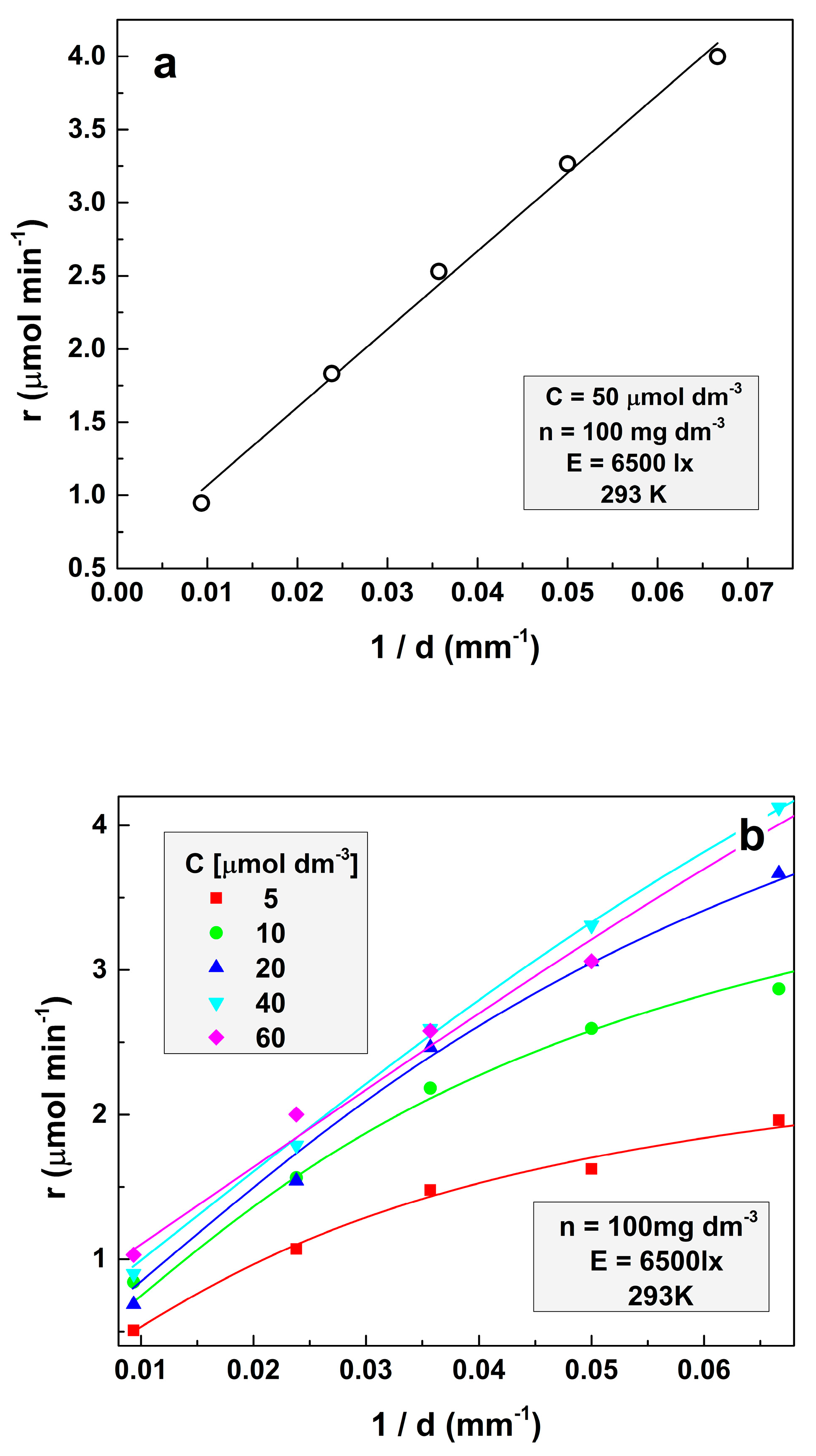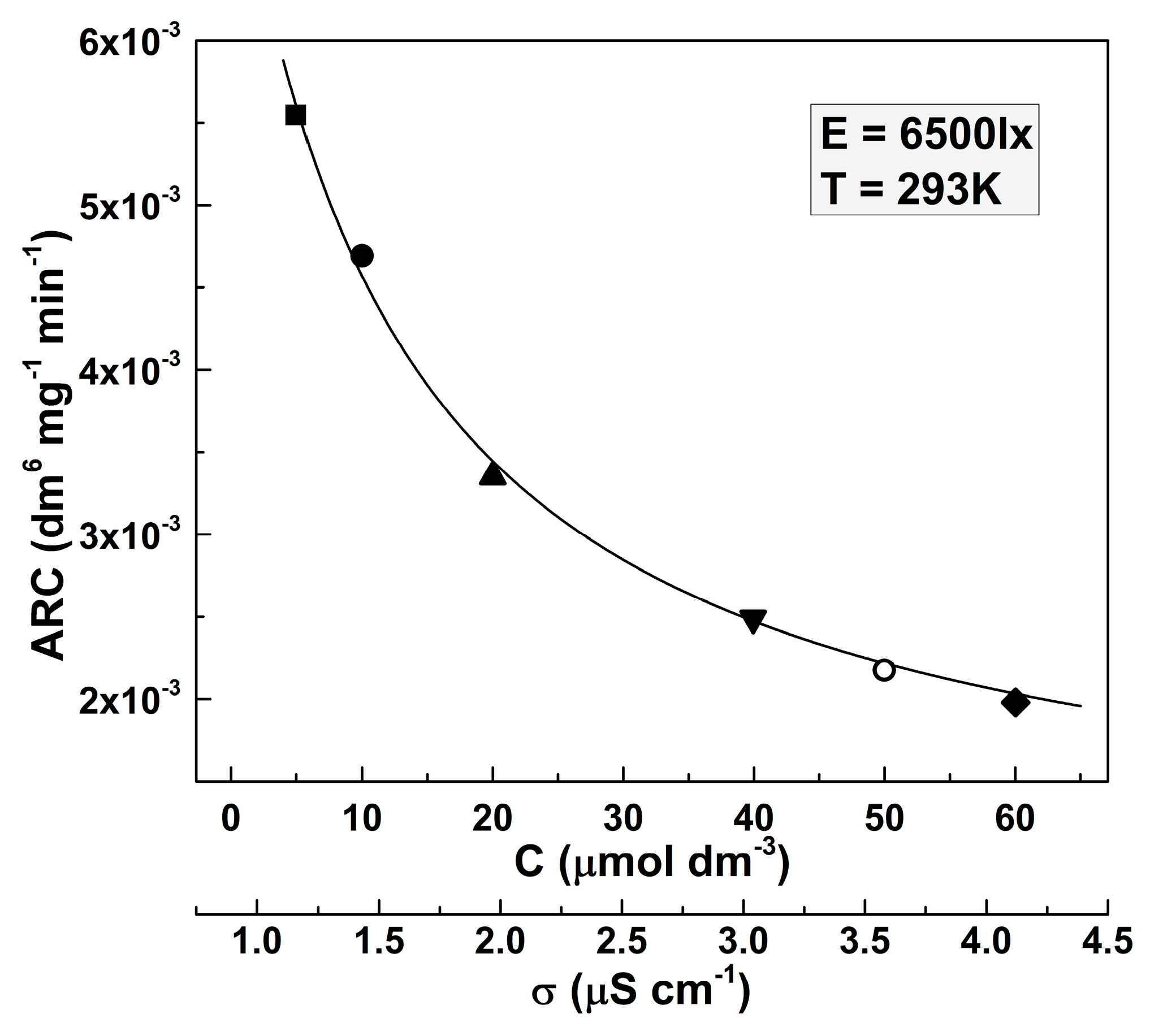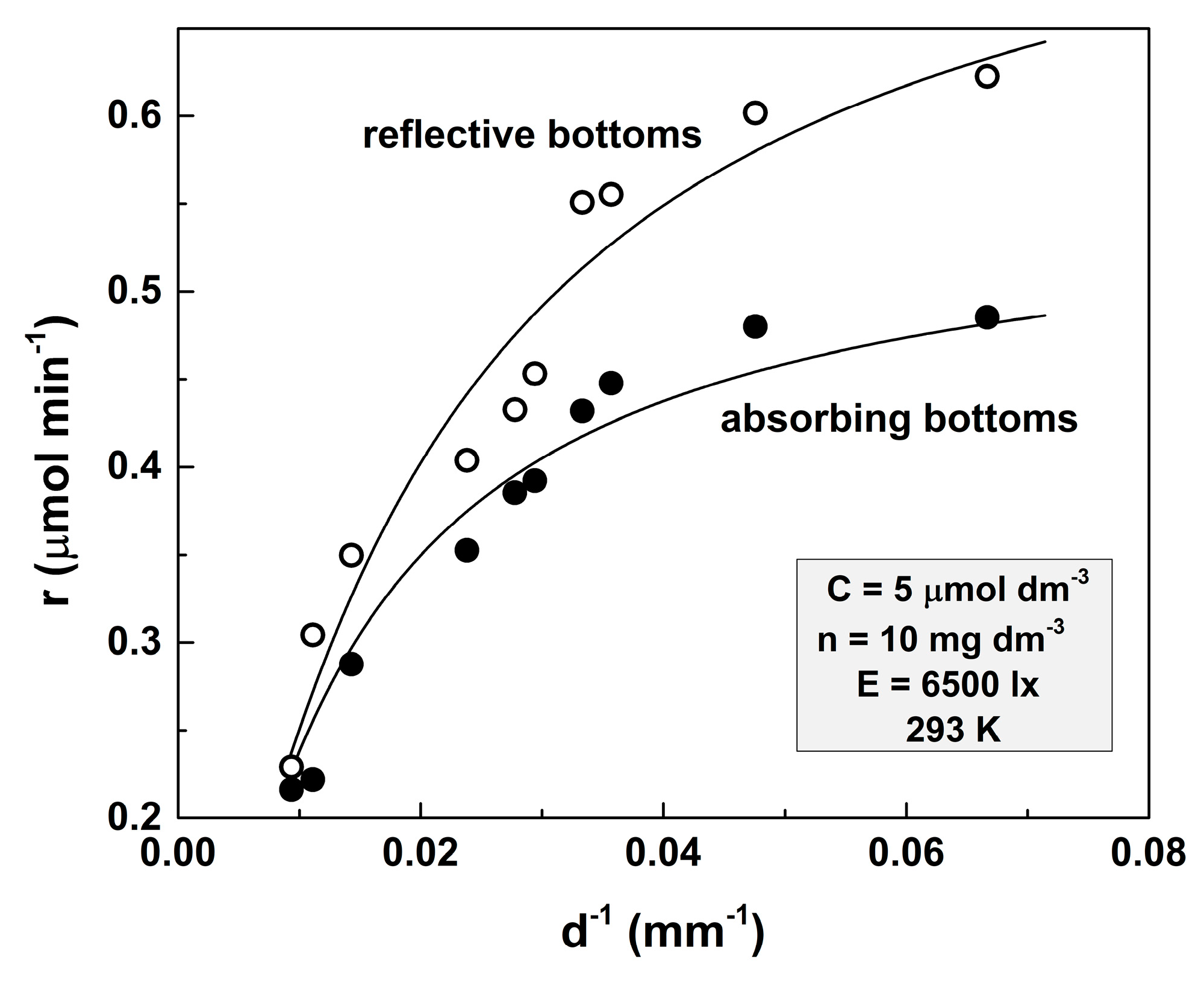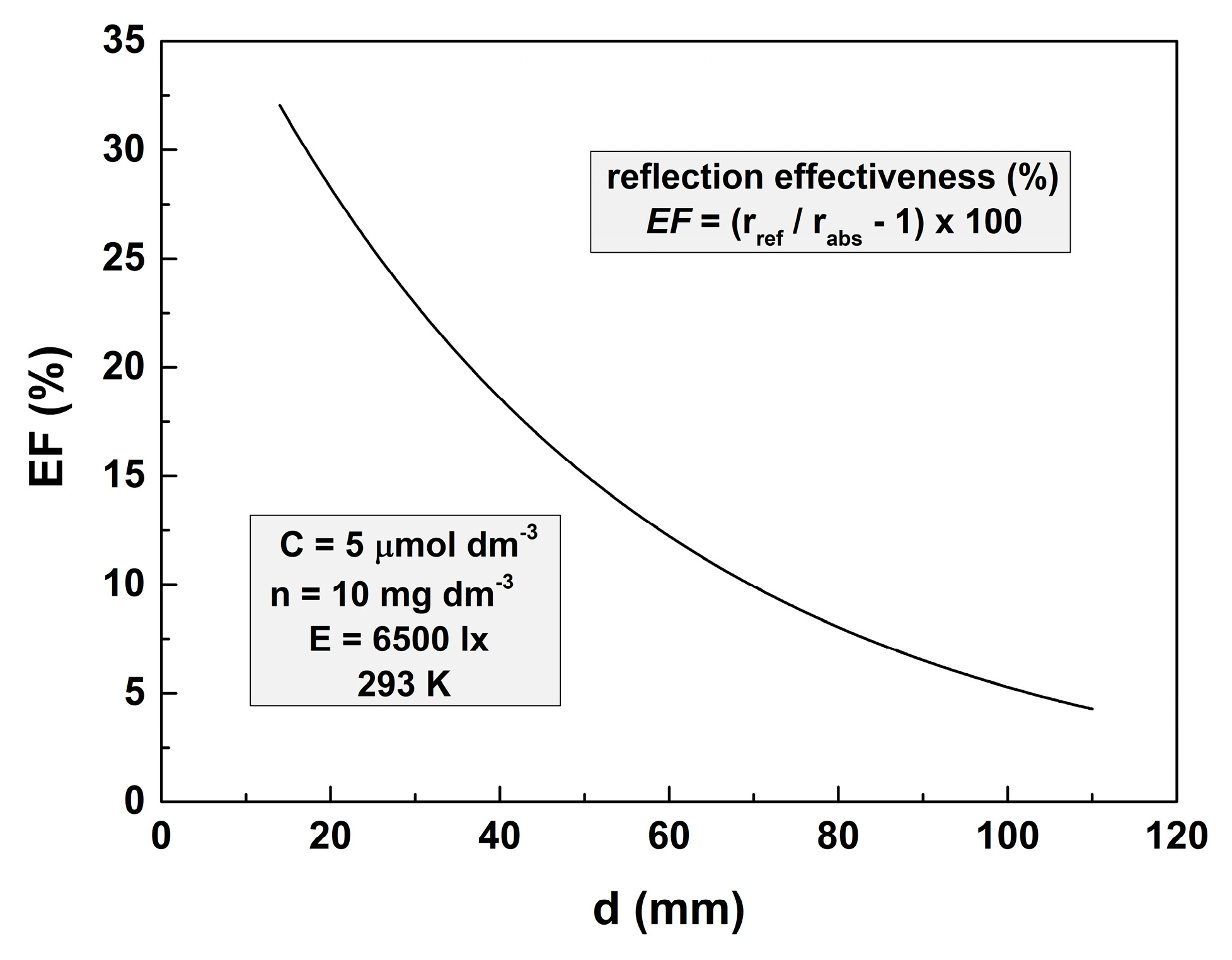Correlation Between the Apparent Rate Constant and the Dye Concentration—Effect of the Bottom Reflection Ability on the Photocatalytic Reaction Rate
Abstract
:1. Introduction
2. Results and Discussion
2.1. Non-Reflective Bottom
2.2. The Effect of the Reflective Bottom
3. Theoretical Background
3.1. When KC Possesses an Ignorable Value (i.e., )
3.1.1. Low Solution Transparency
3.1.2. High Solution Transparency
3.2. When the KC Value Cannot Be Ignored (i.e., KC Comparable to 1)
3.3. Decomposition Kinetics at the Occurrence of a Reflection from the Bottom
4. Materials and Methods
5. Conclusions
- (1)
- The apparent rate constant of the reaction decreases with the increase of the dye concentration according to a hyperbolic law. This correlation could be explained by the increased solution conductivities at higher MO concentrations. The curvatures of the lines, describing the dependence of the reaction rate on the solution depth, gradually weaken with increasing dye concentration;
- (2)
- It is possible to evaluate independently the values of the rate constant and the adsorption equilibrium constant for the photocatalytic degradation reaction if it is assumed that the value of the adsorption equilibrium constant could be greater than 105–106;
- (3)
- The use of a reflective bottom of the vessel could significantly increase the rate of the reaction in case of solutions with rather high transparency and relatively low layer thicknesses;
- (4)
- The effectiveness of the reflective bottom decreases with the increase of the solution layer thickness.
Author Contributions
Funding
Data Availability Statement
Conflicts of Interest
References
- Bobirică, L.; Bobirică, C.; Lupu, G.I.; Orbeci, C. Influence of operating parameters on photocatalytic oxidation of 2,4-dichlorofenol in aqueous solution by TiO2/stainless steel photocatalytic membrane. Appl. Sci. 2021, 11, 11664. [Google Scholar] [CrossRef]
- Blažeka, D.; Car, J.; Klobuchar, N.; Jurov, A.; Zavašnik, J.; Jagodar, A.; Kovachevich, E.; Krstulovi, N. Photodegradation of methylene blue and rhodamine B using laser synthesized ZnO nanoparticles. Materials 2020, 13, 4357. [Google Scholar] [CrossRef] [PubMed]
- Zhang, D.; Lv, S.; Luo, Z. A study on the photocatalytic degradation performance of a [KNbO3]0.9-[BaNi0.5Nb0.5O3−δ]0.1 perovskite. RSC Adv. 2020, 10, 1275–1280. [Google Scholar] [CrossRef] [PubMed]
- Yao, W.F.; Xu, X.H.; Wang, H.; Zhou, J.T.; Yang, X.N.; Zhang, Y.; Shang, S.X.; Huang, B.B. Photocatalytic property of perovskite bismuth titanate. Appl. Catal. B Environ. 2004, 52, 109–116. [Google Scholar] [CrossRef]
- Borji, S.H.; Nasseri, S.; Mahvi, A.H.; Nabizadeh, R.; Javadi, A.H. Investigation of photocatalytic degradation of phenol by Fe(III)-doped TiO2 and TiO2 nanoparticles. J. Environ. Health Sci. Eng. 2014, 12, 101. [Google Scholar] [CrossRef] [PubMed]
- San, N.; Hatipoǧlu, A.; Koçtürk, G.; Çınar, Z. Prediction of primary intermediates and the photodegradation kinetics of 3-aminophenol in aqueous TiO2 suspensions. J. Photochem. Photobiol. A 2001, 139, 225–232. [Google Scholar] [CrossRef]
- Bahrudin, N. Evaluation of degradation kinetic and photostability of immobilized TiO2/activated carbon bilayer photocatalyst for phenol removal. Appl. Surf. Sci. Adv. 2022, 7, 100208. [Google Scholar] [CrossRef]
- Chen, S.; Liu, J.; Liu, P.; Yu, B. Investigation of photocatalytic degradation of methyl orange by using nano-sized ZnO catalysts. Adv. Chem. Eng. Sci. 2011, 1, 9–14. [Google Scholar] [CrossRef]
- Mohamed, R.; Mkhalid, I.; Baeissa, E.; Al-Rayyani, M. Photocatalytic degradation of methylene blue by Fe/ZnO/SiO2 nanoparticles under visible light. J. Nanotechnol. 2012, 2012, 329082. [Google Scholar] [CrossRef]
- Neena, D.; Kondamareddy, K.; Bin, H.; Lu, D.; Kumar, P.; Dwivedi, R.K.; Pelenovich, V.; Zhao, X.; Gao, W.; Fu, D. Enhanced visible light photodegradation activity of RhB/MB from aqueous solution using nanosized novel Fe-Cd co-modified ZnO. Sci. Rep. 2018, 8, 10691. [Google Scholar] [CrossRef]
- Bhapkar, A.; Prasad, R.; Jaspal, D.; Shirolkar, M.; Gheisari, K.; Bhame, S. Visible light driven photocatalytic degradation of methylene blue by ZnO nanostructures synthesized by glycine nitrate auto combustion route. Inorg. Chem. Commun. 2023, 148, 110311. [Google Scholar] [CrossRef]
- Saquib, M.; Muneer, M. TiO2-mediated photocatalytic degradation of a triphenylmethane dye (gentian violet), in aqueous suspensions. Dyes Pigm. 2003, 56, 37–49. [Google Scholar] [CrossRef]
- Megatif, L.; Dillert, R.; Bahnemann, D. Reaction rate study of the photocatalytic degradation of dichloroacetic acid in a black body reactor. Catalysts 2019, 9, 635. [Google Scholar] [CrossRef]
- Lilov, E.; Lilova, V.; Nedev, S.; Adam, A.M.; Kozhukharov, S.; Girginov, C. Depth dependence of the photocatalytic reaction rate. kinetic model generalization. Phys. Scr. 2023, 98, 095001. [Google Scholar] [CrossRef]
- Kaur, J.; Bansal, S.; Singhal, S. Photocatalytic degradation of methyl orange using ZnO nanopowders synthesized via thermal decomposition of oxalate precursor method. Phys. B Condens. Matter 2013, 416, 33–38. [Google Scholar] [CrossRef]
- Vallejo, W.; Cantillo, A.; Díaz-Uribe, C. Methylene blue photodegradation under visible irradiation on Ag-doped ZnO thin films. Int. J. Photoenergy 2020, 2020, 1627498. [Google Scholar] [CrossRef]
- Srisai, J.; Muangnapoh, T.; Vas-Umnuay, P. Comparative study on photocatalytic degradation of methylene blue using pristine ZnO and Ni/ZnO composite films. Mater. Today Proceed. 2022, 66, 3168–3173. [Google Scholar] [CrossRef]
- Eswaran, P.; Madasamy, P.; Pillay, K.; Brink, H. Sunlight-driven photocatalytic degradation of methylene blue using ZnO/biochar nanocomposite derived from banana peels. Biomass Conv. Biorefin. 2024, 2024, 1–21. [Google Scholar] [CrossRef]
- Negash, A.; Mohammed, S.; Weldekirstos, H.; Ambaye, A.; Gashu, M. Enhanced photocatalytic degradation of methylene blue dye using eco-friendly synthesized rGO@ZnO nanocomposites. Sci. Rep. 2023, 13, 22234. [Google Scholar] [CrossRef]
- Di Mauro, A.; Fragalà, M.; Privitera, V.; Impellizzeri, G. ZnO for application in photocatalysis: From thin films to nanostructures. Mater. Sci. Semicond. Process. 2017, 69, 44–51. [Google Scholar] [CrossRef]
- Shakoor, M.H.; Shakoor, M.B.; Jilani, A.; Ahmed, T.; Rizwan, M.; Dustgeer, M.; Iqbal, J.; Zahid, M.; Yong, J. Enhancing the photocatalytic degradation of methylene blue with graphene oxide-encapsulated g-C3N4/ZnO ternary composites. ACS Omega 2024, 9, 16187–16195. [Google Scholar] [CrossRef]
- Rafi, J.A.; Kanda, Y.; Honda, M.; Ichikawa, Y. Annealing effects of ZnO thin film on photocatalytic performances of graphene composites. C J. Carbon Res. 2023, 10, 4. [Google Scholar] [CrossRef]
- Widyastuti, E.; Hsu, J.-L.; Lee, Y.-C. Insight on photocatalytic and photoinduced antimicrobial properties of ZnO thin films deposited by HiPIMS through thermal oxidation. Nanomaterials 2022, 12, 463. [Google Scholar] [CrossRef] [PubMed]
- Rabeel, M.; Javed, S.; Khan, R.; Akram, M.; Rehman, S.; Kim, D.; Khan, M. Controlling the wettability of ZnO thin films by spray pyrolysis for photocatalytic applications. Materials 2022, 15, 3364. [Google Scholar] [CrossRef]
- Chebwogen, J.; Maghanga, C. Fabrication and characterization of cobalt-pigmented anodized zinc for photocatalytic application. Int. J. Thin. Film. Sci. Technol. 2020, 9, 127–132. [Google Scholar] [CrossRef]
- Cambrussi, A.; Morais, A.; Neris, A.; Osajima, J.; Filho, E.; Ribeiro, A. Photodegradation study of TiO2 and ZnO in suspension using miniaturized tests. Matéria (Rio J.) 2019, 24, e12482. [Google Scholar] [CrossRef]
- Mittal, M.; Sharma, M.; Pandey, O.P. UV–Visible light induced photocatalytic studies of Cu doped ZnO nanoparticles prepared by co-precipitation method. Sol. Energy 2014, 110, 386–397. [Google Scholar] [CrossRef]
- Harito, C.; Zaidi, S.; Bavykin, D.; Martins, A.; Yuliarto, B.; Walsh, F.; de León, C. PbO2 decorated ZnO-TiO2 core-shell nanoflower structures by zinc anodising for photo- and anodic degradation of Reactive Black-5 dye. Adv. Nat. Sci. Nanosci. Nanotechnol. 2020, 11, 035018. [Google Scholar] [CrossRef]
- Semeraro, P.; Bettini, S.; Sawalha, S.; Pal, S.; Licciulli, A.; Marzo, F.; Lovergine, N.; Valli, L.; Giancane, G. Photocatalytic degradation of tetracycline byZnO/γ-Fe2O3 paramagnetic nanocomposite material. Nanomaterials 2020, 10, 1458. [Google Scholar] [CrossRef]
- Asefa, G.; Negussa, D.; Lemessa, G.; Alemu, T. The study of photocatalytic degradation kinetics and mechanism of malachite green dye on Ni–TiO2 surface modified with polyaniline. J. Nanomater. 2024, 2024, 5259089. [Google Scholar] [CrossRef]
- Tran, H.; Nguyen, D.; Do, P.; Tran, U. Kinetics of photocatalyt.ic degradation of organic compounds: A mini-review and new approach. RSC Adv. 2023, 13, 16915–16925. [Google Scholar] [CrossRef] [PubMed]
- James, F.; Roos, M. Minuit—A system for function minimization and analysis of the parameter errors and correlations. Comput. Phys. Commun. 1975, 10, 343–367. [Google Scholar] [CrossRef]
- Lilov, E.; Nedev, S.; Lilova, V.; Kozhukharov, S.; Girginov, C. Solution conductivity as a factor determining the photocatalytic reaction rate. J. Photochem. Photobiol. 2024, 21, 100240. [Google Scholar] [CrossRef]
- Banisi, S.; Finch, J.A.; Laplante, A.R. Electrical conductivity of dispersions: A review. Miner. Eng. 1993, 6, 369–385. [Google Scholar] [CrossRef]
- Chen, T.; Zheng, Y.; Lin, J.-M.; Chen, G. Study on the photocatalytic degradation of methyl orange in water using Ag/ZnO as catalyst by liquid chromatography electrospray ionization ion-trap mass spectrometry. J. Am. Soc. Mass Spectrom. 2008, 19, 997–1003. [Google Scholar] [CrossRef]




Disclaimer/Publisher’s Note: The statements, opinions and data contained in all publications are solely those of the individual author(s) and contributor(s) and not of MDPI and/or the editor(s). MDPI and/or the editor(s) disclaim responsibility for any injury to people or property resulting from any ideas, methods, instructions or products referred to in the content. |
© 2025 by the authors. Licensee MDPI, Basel, Switzerland. This article is an open access article distributed under the terms and conditions of the Creative Commons Attribution (CC BY) license (https://creativecommons.org/licenses/by/4.0/).
Share and Cite
Lilov, E.; Nedev, S.; Lilova, V.; Girginov, C.; Kozhukharov, S. Correlation Between the Apparent Rate Constant and the Dye Concentration—Effect of the Bottom Reflection Ability on the Photocatalytic Reaction Rate. Catalysts 2025, 15, 347. https://doi.org/10.3390/catal15040347
Lilov E, Nedev S, Lilova V, Girginov C, Kozhukharov S. Correlation Between the Apparent Rate Constant and the Dye Concentration—Effect of the Bottom Reflection Ability on the Photocatalytic Reaction Rate. Catalysts. 2025; 15(4):347. https://doi.org/10.3390/catal15040347
Chicago/Turabian StyleLilov, Emil, Svetlozar Nedev, Vanya Lilova, Christian Girginov, and Stephan Kozhukharov. 2025. "Correlation Between the Apparent Rate Constant and the Dye Concentration—Effect of the Bottom Reflection Ability on the Photocatalytic Reaction Rate" Catalysts 15, no. 4: 347. https://doi.org/10.3390/catal15040347
APA StyleLilov, E., Nedev, S., Lilova, V., Girginov, C., & Kozhukharov, S. (2025). Correlation Between the Apparent Rate Constant and the Dye Concentration—Effect of the Bottom Reflection Ability on the Photocatalytic Reaction Rate. Catalysts, 15(4), 347. https://doi.org/10.3390/catal15040347





